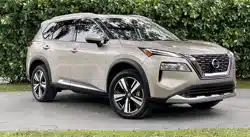Loading ...
Loading ...
Loading ...

5-70 Starting and driving
— Pedestrians, bicycles, animals.
— Vehicles such as motorcycles,
low height vehicles, or high
ground clearance vehicles.
— Vehicles remaining in the de-
tection zone when you accel-
erate from a stop.
— Oncoming vehicles.
— A vehicle merging into an
adjacent lane at a speed ap-
proximately the same as your
vehicle.
— A vehicle approaching rapidly
from behind.
— A vehicle which your vehicle
overtakes rapidly.
— A vehicle that passes through
the detection zone quickly.
. The radar sensor’s detection zone
is designed based on a standard
lane width. When driving in a
wider lane, the radar sensors
may not detect vehicles in an
adjacent lane. When driving in a
narrow lane, the radar sensors
may detect vehicles driving two
lanes away.
. The radar sensors are designed
to ignore most stationary objects,
however objects such as guard-
rails, walls, foliage and parked
vehicles may occasionally be de-
tected. This is a normal operation
condition.
. The following conditions may re-
duce the ability of the radar to
detect other vehicles:
— Severe weather
— Road spray
— Ice/frost/dirt build-up on the
vehicle
. Do not attach stickers (including
transparent material), install ac-
cessories or apply additional
paint near the radar sensors.
These conditions may reduce the
ability of the radar to detect other
vehicles.
. The camera may not detect lane
markers in the following situa-
tions and the I-BSI system may
not operate properly.
— On roads where there are
multiple parallel lane markers;
lane markers that are faded or
not painted clearly; yellow
painted lane markers; non-
standard lane markers; lane
markers covered with water,
dirt, snow, etc.
— On roads where discontinued
lane markers are still detect-
able.
— On roads where there are
sharp curves.
— On roads where there are
sharply contrasting objects,
such as shadows, snow,
water, wheel ruts, seams or
lines remaining after road re-
pairs.
— On roads where the traveling
lane merges or separates.
— When the vehicle’s traveling
direction does not align with
the lane markers.
— When traveling close to the
vehicle in front of you, which
obstructs the lane camera
unit detection range.
— When rain, snow or dirt ad-
heres to the windshield in
front of a lane camera unit.
— When the headlights are not
bright due to dirt on the lens
or if aiming is not adjusted
Loading ...
Loading ...
Loading ...
